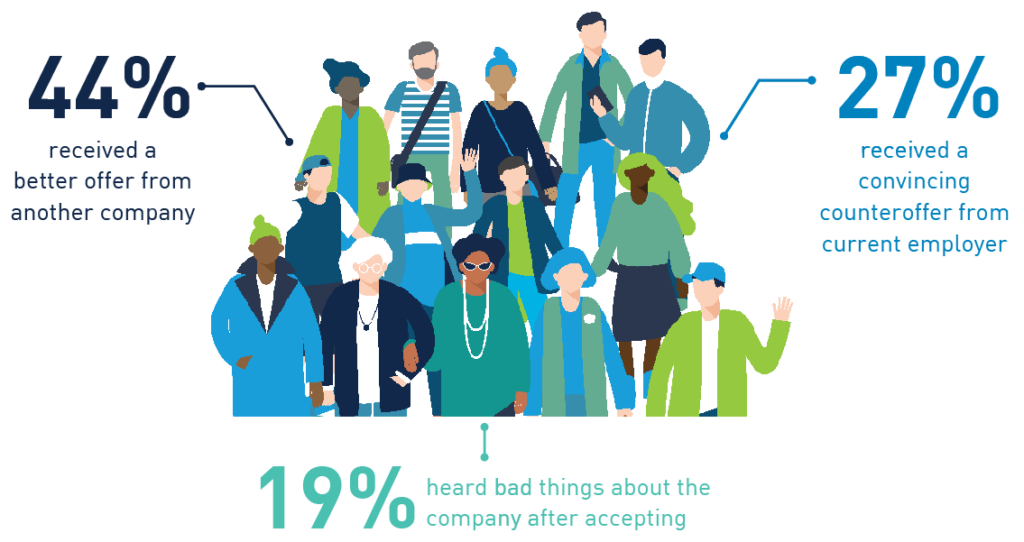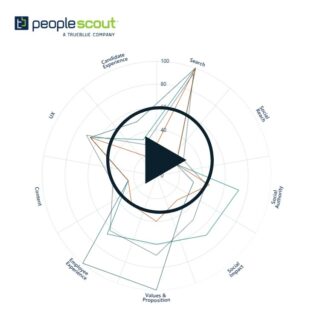Candidate engagement after extending a job offer is now more important than ever, as employers across most regions are seeing a dramatic increase in the number of new hires who are ghosting on their first day: Data from Robert Half shows that 28% of professionals have backed out of a job offer after initially accepting it, thereby costing employers time and money on a job offer ghosted.
In today’s candidate-driven market—and with the major influence that the pandemic had on the way people view work and personal life—it’s no surprise that candidates are receiving multiple job offers and thinking critically about what they truly want in an employer.
Top 3 Reasons Candidates Backed Out of an Offer They’ve Already Accepted

With candidates in the driver’s seat, employers need to do everything they can to keep new hires from taking an early exit. So, in this article, we offer actionable strategies for your organization to do just that.
Why Do Candidates Ghost?
With record numbers of job openings, job-seekers are more empowered than ever to be picky about the company they choose to work for. This means that candidates are likely interviewing with multiple companies at the same time—and they may not disclose it.
At the same time, the COVID-19 pandemic was a catalyst for an immense digital transformation of the recruiting process, with everything from phone screens and interviews to offers and onboarding being conducted completely online. Of course, while this has made it easier and faster to apply to jobs (with “easy apply” options and text interviews the norm), it has also informalized the process and made it feel less personal than a face-to-face hiring journey.
As a result, employers who rely solely on these technologies without establishing a human touch might struggle to build a more personal connection with candidates. Furthermore, because the majority of the hiring process now takes place online from behind a screen, it can be difficult for recruiters and candidates to build the same rapport that they would have when communicating in person; when you remove the investment that comes from traveling to meet someone in person and replace it with a simple click, the entire process can start to feel more transactional and less human.
All of this can lead to poor communication overall, leaving candidates feeling like they might not need to provide any formal closure. According to Indeed data, here are some of the consequences of ineffective communication with the recruiter or hiring manager:

And, not only is ghosting happening, but it also appears to be a rapidly growing trend: According to a 2021 survey from Indeed, 28% of job-seekers have ghosted an employer—a 10% increase from 2019 data—and 57% of employers believe it’s more common than ever before.
It’s important to note that the same Indeed survey found that ghosting in the workplace is a two-way street, with 77% of job-seekers saying they’ve been ghosted by an employer. So, while ghosting has become a normalized part of the hiring process (with employers starting the trend and candidates catching on), there are some actionable steps that employers can take to avoid ghosting on both ends and help combat this rising trend.
Strategies to Keep Candidates Engaged After Job Offer Acceptance
In addition to the increasing likelihood that candidates will renege on an offer, employers should also keep in mind the various notice period requirements in countries around the world, which could be anywhere from two weeks to six months, in some places. Clearly, half a year is an incredibly long time to keep someone engaged and excited about your business, especially when that candidate is exploring other offers and evaluating the benefits of each. So, how can you do it? Consider the following:
Focus on Employer Brand
It should come as no surprise that keeping candidates engaged after they accept an offer starts with the work that’s done prior to them even applying; maintaining a powerful employer brand is key to keeping candidates with you throughout the entire hiring process. More precisely, when a candidate receives a competing offer or a compelling counteroffer from their current employer, is what your company offers going to be enough to keep them from changing their mind?
To that end, it’s important that your organization presents itself—on social media, employer review sites and your careers site—in a positive light. You’ll want the candidate to be reminded of the value you offer—whether that’s in the form of benefits; flexibility; growth opportunities; diversity and inclusion initiatives; or otherwise—everywhere they look. The mental picture a candidate keeps of you in the back of their mind (or when someone mentions your company’s name) is make or break when it comes to them following through on an offer acceptance and showing up for day one.
Make Open Communication Standard
Lack of communication is one of the top reasons candidates ghost after accepting an offer, so establishing strong, open lines of communication from the start can make a huge difference in how the hiring process plays out. For example, encourage recruiters and hiring managers to communicate with candidates frequently by keeping them informed of their application status, providing updates on next steps and simply checking in to see if candidates have any questions. This can help build a sense of familiarity and rapport that is often lost when recruiters only communicate when absolutely necessary.
Your organization can also stand out from others by candidly asking candidates where they are in the hiring process with other potential employers. Then, depending on your recruitment timeline, you can adjust key interviews and deadlines to avoid losing your candidate to a competing job offer. A personalized offer letter for job candidates will place you ahead of competitors. This will also help you get an idea of whether your candidate is entertaining other offers that they may be more interested in overall; then, even if they do accept an offer from you, this can help you be better prepared for the possibility that they’ll renege and accept a position elsewhere.
Finally, the key is to maintain that line of communication even after the candidate has accepted an offer; if you ghost your brand-new hire, they’ll be more likely to ghost you in turn.
Get the Offer Out Fast
The more time your hiring process takes, the more time candidates have to consider taking other jobs. You’ve received a verbal offer acceptance; that’s great. Now, the time it takes for you to get official paperwork out and signed is critical. Engagement levels are highest at this point, and it’s critical that you get the offer out before the candidate has the chance to get cold feet.
If possible, get all of your organization’s internal approvals finalized prior to your verbal offer so that the official written offer can be sent almost immediately. If your organization has a lengthier process that cannot be shortened, then be sure to communicate that to the candidate so their expectations are set accordingly.
Utilize Thoughtful Touchpoints
Perhaps most important, maintain frequent communication with the candidate during the period between offer acceptance (whether verbal or written) and day one. This can include messages of congratulations from the hiring manager and anyone else they may have met and interviewed with during the hiring process.
Additionally, consider pairing your new hire with a current employee who can help them prepare for their first day. Or, in smaller organizations, set up a one-on-one meeting with a key leader to welcome them to the company. This can help the candidate feel connected to the team before they’ve even officially started—and will help keep the organization front of mind.
Redefine Onboarding & Start Immediately
When competing with multiple offers and long notice periods, beginning your onboarding process before the new hire officially starts can be a great way to keep them engaged and feeling like they’re a part of the team. For instance, if you’re in an office, consider sending your new hire a video tour or inviting them in for a real one. Or, if your team is planning to get together for an in-person or virtual happy hour, invite the new hire to join.
You can also send your new hire more information about your company, culture, employee resource groups and more to help them start feeling like a part of the team. Plus, what better way to foster a sense of connection and pride than by sending a welcome kit and some company swag? Finally, encourage the new hire’s colleagues and manager to reach out frequently to check in and express excitement for them to officially get started on the team.
The Whole Job Offer Package
Essentially, candidate experience is really about the whole package—from establishing a strong employer brand all the way to onboarding. How you present your organization—as well as how it’s perceived by the public—is paramount. Moreover, remaining front of mind for candidates throughout the entire hiring process (and especially post-offer) is critical so as not to lose them to competing offers or a change of heart. In today’s market, employers can’t afford to slip and miss any opportunity for communication, connection and engagement.



